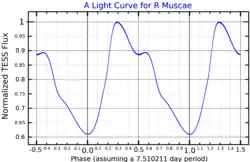| Observation data Epoch J2000 Equinox J2000 | |
|---|---|
| Constellation | Musca |
| Right ascension | 12h 42m 05.02561s[2] |
| Declination | −69° 24′ 27.1966″[2] |
| Apparent magnitude (V) | 5.93 - 6.73[3] |
| Characteristics | |
| Spectral type | F7 Ib[4] - G2[3] |
| B−V color index | 0.750±0.020[5] |
| Variable type | δ Cep[3] |
| Astrometry | |
| Radial velocity (Rv) | +3.8±2.9[6] km/s |
| Proper motion (μ) | RA: −4.180[2] mas/yr Dec.: −2.127[2] mas/yr |
| Parallax (π) | 1.0002 ± 0.0291 mas[2] |
| Distance | 3,260 ± 90 ly (1,000 ± 30 pc) |
| Absolute magnitude (MV) | -3.62[7] |
| Details | |
| Radius | 65[2] R☉ |
| Luminosity | 2,541[2] L☉ |
| Surface gravity (log g) | 2.0±0.1[8] cgs |
| Temperature | 5,985±54[7] K |
| Metallicity [Fe/H] | +0.10±0.05[8] dex |
| Other designations | |
| Database references | |
| SIMBAD | data |
R Muscae is a yellow-white hued variable star in the southern constellation of Musca. It has a nominal apparent visual magnitude of 6.31,[5] which is near the lower limit of visibility to the naked eye. The distance to this star, as determined from its annual parallax shift of 1.00 mas,[2] is around 3,260 light years.
This is an F-type supergiant star with a baseline stellar classification of F7 Ib.[4] It is a Classical Cepheid variable ranging from apparent magnitude 5.93 to 6.73[10] over 7.51 days,[7] while varying between spectral types F7 Ib and G2.[10] The star was suspected of having a detectable companion,[11] but this finding was later disputed.[12] Gaia and HST observations have shown that there is a companion, a 15th-magnitude star 7″ away.[13][14] There is an X-ray source with a luminosity of 6.3×1029 erg s−1 located at an angular separation of 1.9″ from R Muscae.[15]
References
- ↑ "MAST: Barbara A. Mikulski Archive for Space Telescopes". Space Telescope Science Institute. Retrieved 8 December 2021.
- 1 2 3 4 5 6 7 8 Brown, A. G. A.; et al. (Gaia collaboration) (August 2018). "Gaia Data Release 2: Summary of the contents and survey properties". Astronomy & Astrophysics. 616. A1. arXiv:1804.09365. Bibcode:2018A&A...616A...1G. doi:10.1051/0004-6361/201833051.
- 1 2 3 Samus', N. N; Kazarovets, E. V; Durlevich, O. V; Kireeva, N. N; Pastukhova, E. N (2017). "General catalogue of variable stars: Version GCVS 5.1". Astronomy Reports. 61 (1): 80. Bibcode:2017ARep...61...80S. doi:10.1134/S1063772917010085. S2CID 125853869.
- 1 2 Houk, Nancy; Cowley, A. P. (1979). Michigan catalogue of two-dimensional spectral types for the HD stars. Vol. 1. Ann Arbor, Michigan: Dept. of Astronomy, University of Michigan. Bibcode:1978mcts.book.....H.
- 1 2 Anderson, E.; Francis, Ch. (2012). "XHIP: An extended hipparcos compilation". Astronomy Letters. 38 (5): 331. arXiv:1108.4971. Bibcode:2012AstL...38..331A. doi:10.1134/S1063773712050015. S2CID 119257644.
- ↑ de Bruijne, J. H. J.; Eilers, A.-C. (October 2012). "Radial velocities for the HIPPARCOS-Gaia Hundred-Thousand-Proper-Motion project". Astronomy & Astrophysics. 546: 14. arXiv:1208.3048. Bibcode:2012A&A...546A..61D. doi:10.1051/0004-6361/201219219. S2CID 59451347. A61.
- 1 2 3 Luck, R. E.; et al. (August 2011). "The Distribution of the Elements in the Galactic Disk. II. Azimuthal and Radial Variation in Abundances from Cepheids". The Astronomical Journal. 142 (2): 12. arXiv:1106.0182. Bibcode:2011AJ....142...51L. doi:10.1088/0004-6256/142/2/51. S2CID 119288363. 51.
- 1 2 Soubiran, Caroline; et al. (2016). "The PASTEL catalogue: 2016 version". Astronomy & Astrophysics. 591: A118. arXiv:1605.07384. Bibcode:2016A&A...591A.118S. doi:10.1051/0004-6361/201628497. S2CID 119258214.
- ↑ "DU Lyncis". SIMBAD. Centre de données astronomiques de Strasbourg. Retrieved 3 September 2018.
- 1 2 BSJ (4 January 2010). "R Muscae". AAVSO Website. American Association of Variable Star Observers. Retrieved 21 December 2013.
- ↑ Lloyd Evans, T. (June 1982). "Cepheid binaries. II. New southern examples". Monthly Notices of the Royal Astronomical Society. 199 (4): 925–941. Bibcode:1982MNRAS.199..925L. doi:10.1093/mnras/199.4.925.
- ↑ Eichendorf, W.; et al. (May 1982). "UV, optical and IR observations of the Cepheid R MUSCAE". Astronomy and Astrophysics. 109 (2): 274–278. Bibcode:1982A&A...109..274E.
- ↑ Kervella, Pierre; Gallenne, Alexandre; Remage Evans, Nancy; Szabados, Laszlo; Arenou, Frédéric; Mérand, Antoine; Proto, Yann; Karczmarek, Paulina; Nardetto, Nicolas; Gieren, Wolfgang; Pietrzynski, Grzegorz (2019). "Multiplicity of Galactic Cepheids and RR Lyrae stars from Gaia DR2. I. Binarity from proper motion anomaly". Astronomy and Astrophysics. 623: A116. arXiv:1903.03632. Bibcode:2019A&A...623A.116K. doi:10.1051/0004-6361/201834210. S2CID 119226246.
- ↑ Evans, Nancy Remage; Pillitteri, Ignazio; Wolk, Scott; Karovska, Margarita; Tingle, Evan; Guinan, Edward; Engle, Scott; Bond, Howard E.; Schaefer, Gail H.; Mason, Brian D. (2016). "Resolved Companions of Cepheids: Testing the Candidates with X-Ray Observations". The Astronomical Journal. 151 (4): 108. arXiv:1602.01797. Bibcode:2016AJ....151..108E. doi:10.3847/0004-6256/151/4/108. S2CID 118500551.
- ↑ Evans, Nancy Remage; et al. (April 2016). "Resolved Companions of Cepheids: Testing the Candidates with X-Ray Observations". The Astronomical Journal. 151 (4): 9. arXiv:1602.01797. Bibcode:2016AJ....151..108E. doi:10.3847/0004-6256/151/4/108. S2CID 118500551. 108.
